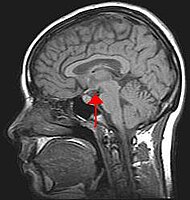
Photo from wikipedia
Central oxytocin receptor (OTR) expression is extremely sensitive to circulating steroid hormones and OTRs influence many of the neurobehavioural adaptations associated with female reproduction (e.g., postpartum caregiving, aggression, cognition, affective… Click to show full abstract
Central oxytocin receptor (OTR) expression is extremely sensitive to circulating steroid hormones and OTRs influence many of the neurobehavioural adaptations associated with female reproduction (e.g., postpartum caregiving, aggression, cognition, affective responses). Changes in central OTR expression across female reproduction have often been studied, but almost all of such research has focused on the forebrain, ignoring hormone‐sensitive midbrain sites such as the serotonergic dorsal raphe (DR) that are also critical for postpartum behaviours. To investigate the effects of female reproductive state on OTRs in the DR, we first used autoradiography to examine OTR binding across four female reproductive states in laboratory rats: dioestrous virgin, pregnancy day 10, the day of parturition and postpartum day 7. OTR binding in the rostral DR (but not other DR subregions) was approximately 250% higher in parturient rats compared to dioestrous virgins and dropped back down to virgin levels by postpartum day 7. Given the chemical heterogeneity of the DR, we then examined OTR expression in the three most abundant neuronal phenotypes of the DR (i.e., serotonin, GABA and dopamine) in dioestrous virgins and recently parturient females. Using dual‐label immunohistochemistry and in situ hybridisation, we found that twice as many dopaminergic cells in the parturient rostral DR contained OTR immunoreactivity compared to that found in virgins. On the other hand, mothers had fewer rostral DR GABAergic cells expressing OTRs than did virgins. OTR expression in serotonin cells did not differ between the two groups. Overall, these results suggest that the rostral subregion of the midbrain DR is uniquely sensitive to oxytocin around the time of parturition, with subpopulations of cells that become more sensitive (i.e., dopamine), less sensitive (i.e., GABA) and show no change (i.e., serotonin) to this neuropeptide. This dynamic OTR signalling in the female DR may help drive the numerous behavioural changes across female reproduction that are necessary for successful motherhood.
Journal Title: Journal of Neuroendocrinology
Year Published: 2021
Link to full text (if available)
Share on Social Media: Sign Up to like & get
recommendations!